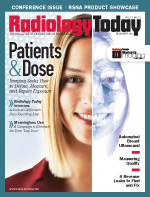 December 2012
December 2012
Measuring Quality to Improve Imaging Care—Radiology IT Should Play Important Role in Reform
By David Yeager
Radiology Today
Vol. 13 No. 12 P. 6
By now, nearly all Americans know the United States spends more money on healthcare than any other country for, in many ways, less-than-top-tier results.
A great deal of the rhetoric about the Affordable Care Act can be boiled down to this question: How do we get more bang for our healthcare buck? Estimates of annual waste in the healthcare system range between $750 billion and $1.2 trillion, according to the Institute of Medicine’s “Best Care at Lower Cost” and PriceWaterhouseCoopers’ “The Price of Excess: Identifying Waste in Healthcare Spending,” respectively. Those huge numbers make it easy to understand why reform has become a hot-button issue.
With another election come and gone, perhaps policy makers, industry experts, and patient advocates can finally get down to the business of wrangling over the details. Whether those efforts produce a measurable effect on the cost of care or patient outcomes is unclear, but it’s a safe bet that change will come.
Because radiology is an integral part of the care process—and accounts for large healthcare expenditures—it will feel those changes as well. In the October issue of the Journal of the American College of Radiology, James V. Rawson, MD, an associate professor of radiology at Georgia Health Sciences University, said increasing radiology utilization combined with relatively high radiologist salaries will make an inviting target for reformers.
One aim of the Affordable Care Act is to offset the cost of insuring millions of uninsured people by delivering medical care more efficiently. Although Rawson expects the particulars of the Affordable Care Act to change quite a bit over the next decade, one change he expects to surface soon is value-based purchasing. Essentially, physicians, including radiologists, increasingly will be asked to demonstrate how their services affect patients.
“Where many radiologists work in hospitals, I think there’s going to be an effort to link physician behavior and performance to the value-based purchasing [of] patient outcomes,” Rawson says.
Outcomes Metrics
Linking radiology to outcomes requires metrics to prove the care truly benefits patients. Rawson points to data that suggest medical imaging can reduce unnecessary hospital admissions, shorten patients’ length of stay, and lower mortality rates as examples of useful metrics. Imaging informatics increasingly will be pressured to go beyond documenting what is done and measure its benefit to patients.
The assessment that many healthcare dollars are wasted—including a significant chunk spent on imaging—reinforces imaging as the inviting target Rawson describes. The PriceWaterhouseCoopers report on healthcare spending identified defensive medicine, such as redundant, inappropriate, or unnecessary tests and procedures, as the single biggest cause of waste. The Institute of Medicine report on care and cost estimates that unnecessary services accounted for $210 billion of waste in 2009. For this reason, Rawson says more research is needed to develop imaging-related metrics that are valuable to both policy makers and patients.
“Providing an additional CT scan that adds cost but doesn’t add an improved outcome to the patient isn’t something that there is really going to be dollars to support as we move further into a healthcare reform environment,” Rawson says.
Decision Support
One tool that could help improve imaging utilization is decision support linked to a computerized physician order entry system. Decision support could allow best practices to be established and make guidelines available at the time a study is ordered, potentially reducing the number of unnecessary imaging exams. Medicare is currently conducting demonstration projects to evaluate decision-support tools.
Structured reporting is another tool that offers opportunities for better utilization management. Rawson says cardiology departments have standardized their reports to a far greater degree than radiology with good results. Radiology could streamline workflow and improve its data pool if structured reporting were adopted on a broader basis. “I think if we looked at structured reporting in radiology, it would allow us the opportunity to do better research on the results of the exams in the larger context of the care continuum,” Rawson says.
Health information exchanges (HIEs) are another tool that may increase efficiency throughout the healthcare system. Rawson says sharing patient information among hospitals and physicians through HIEs would provide clinicians with a holistic view of a patient’s care rather than the fragmented views that are currently the norm. Better information exchange could potentially lower costs and improve care by reducing unnecessary medical imaging and other tests.
Although nascent HIE efforts are under way, many technical and regulatory hurdles still need to be addressed. Rawson recommends that radiologists support these efforts, but he doesn’t expect progress to be made quickly. However, as more HIEs come online, larger, more efficient networks will be created. “I don’t see this as a single-step process. I think this is multiple steps beginning with small HIEs and beginning to link them together to form a meaningful network,” Rawson says. “It won’t happen immediately.”
With millions of baby boomers reaching retirement age over the next 20 years, it is nearly certain that the demand for radiology services will remain high, but there will be pressure to better measure its worth. The challenge for radiology departments in this regard will be to produce data and develop protocols that allow the demand to be met in a more clinically effective and efficient way.
— David Yeager is a freelance writer and editor based in Royersford, Pennsylvania.

